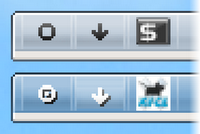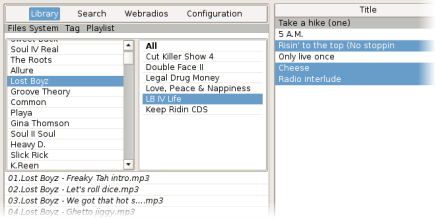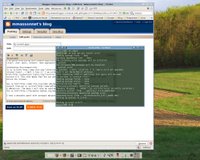One month without any message
I was busy. And I'm still busy.I'm coding a new xfce4-notes-plugin for the new panel (version 4.4). It is fun :) I already have access on the webpages and the svn (or I guess so, I'm working on a local subversion at the moment). Should be released at end of the week, actually when I will add the on_delete_page callback. It supports multiple notes and some options for the window aspect (always on top, stick, show in taskbar, show at startup).
Also, I was at RMLL2006, and there was a wet man searching the reception... it was p0llux! After one day I ran sick... because of the heat. I was lug around Vandoeuvre to get in a Pharmacy (thanks guys). I didn't assist any conference all the week :/
See you in the next post about the first release of xfce4-notes-plugin.
Theming is my actual pleasure
Xfwm4
 I did some theming around the original theme of Xfce 4.4.
I did some theming around the original theme of Xfce 4.4.All I wanted was the title bar to be a bit smaller. I managed to reduce it from 6 pixels. Then I simplified the buttons. The work was quite long with redundant actions, well it is what it is. Now I have my theme :)
I posted my modifications at Xfce-look.org.
ajaxMP
 I also did a theme for ajaxMP a little time ago which is based on Xfce-dawn theme (which is my current theme moreover). ajaxMP is a web interface for Music Daemon Player. I already mentionned it in the post "My current apps".
I also did a theme for ajaxMP a little time ago which is based on Xfce-dawn theme (which is my current theme moreover). ajaxMP is a web interface for Music Daemon Player. I already mentionned it in the post "My current apps".I am also working on a web design in black for a french rap production. They have very good instrumentals and I am sure the CD they are producting will kick ass. However I prefer good old Pink Floyd at this time.
Cheers.
Configuration
Hi,
so I’d like to do some idle talk about simplifying the configuration system of Xfce4.5.
All the possibilities I heard so far do not go far enough.
What I’d like to see is it to be simplified to the max by:
using one (real) file per setting (yes _setting_) in “.config/xfce4/”If the setting points to a file (for example background image), it should be a symlink to the file. Otherwise it should be a regular file containing the value as readable string.
So for our (more or less) current settings,
http://xfce.wikia.com/wiki/Simple_Settings
That isn’t all that much, is it?
Advantages are:
* simple to copy/merge
* simple to understand
* can use all the normal unix tools
(symlink the important ones to another directory etc)
simple to change by script
uses normal unix tree api and doesn’t introduce another version of it (xml, ini file, whatever)
uses file change notification to be notified of changes (not xsettings)
Disadvantage:
* wastes space on old filesystems – aren’t that many files though!
As a means to fix the only remaining disadvantage, I’d suggest writing/mounting a FUSE module that stores the settings in a bdb or something.
Let the sun shine
Just wanted to say that Nick Schermer is my hero, because he fixed the weather plugin!
So, for good measure, I’ll throw in a new screenie, because I see the last one dated from January: Screenshot .
The background image was shot on our holiday in Italy, where we went hiking in the Alpi Liguri. I can recommend it to anyone — if you aren’t afraid of a few blisters, that is… ;-)
My current apps
Hi,I am gonna show you my more commons applications. This will include: desktop environment, email client, chat, music, browser, news aggregator, file manager and other thingies.
Desktop Environment
It is Xfce! No you didn't guess it? even with all my Xfce related links? :-) Well I like it. I am currently using the svn version which is gonna be the next stable release, version 4.4. This also means that the svn won't see new features which could broke the code before the release.
See here how to install from svn or get the 4.4Beta1. The Beta 1 will also be available in Debian/Sid as soon as some libs get out from the NEW state.
 I have a moveable panel with worspace margins. If I am missing a workspace I just type ALT+Insert. At the opposite I type ALT+Delete ;) There are nice plugins for the panel. I am using the window list plugin to not feed my display with a large panel and buttons of applications on it. I have a clipboard manager for the default and primary clipboard. There is a box execution which does autocompletion and history: verve. There is also a systray box and clock plugins. Furthermore there are monitoring plugins for network (netload), system (systemload and cpugraph) and sound (xfce4-mixer).
I have a moveable panel with worspace margins. If I am missing a workspace I just type ALT+Insert. At the opposite I type ALT+Delete ;) There are nice plugins for the panel. I am using the window list plugin to not feed my display with a large panel and buttons of applications on it. I have a clipboard manager for the default and primary clipboard. There is a box execution which does autocompletion and history: verve. There is also a systray box and clock plugins. Furthermore there are monitoring plugins for network (netload), system (systemload and cpugraph) and sound (xfce4-mixer).Email Client
I am completely amazed with Sylpheed-Claws 2.2. It does the GNUPG signatures and encryptions. It supports filtering and, something new I learned from it, treatments on folders when you enter them, for instance it is very useful to move old emails into archives. It has a systray icon and I have setup a `playsound new_mail.ogg` when I get new emails. You can read the different parts (mime types) of an email just by clicking on buttons on the side (useful for HTML docs or attached patches). I like it, actually it is ass-kicking!
Chat (IRC, Jabber)
irssi and Gajim are my all and one at the moment.
irssi always fits into a screen, and if it is not running, this is my command line: screen -S irssi irssi, and next I will be able to detach, attach, reattach, multiple attach it in any Terminal I want. Recently I received a nice screenrc from omp. With this configuration I am able to see the numbers with names of the windows at the bottom (this rocks!). In irssi you can easily add a server or a channel to auto join, an alias or set the layout. Just type /help for this commands, or better, just type /help ;) My preferred theme is madcow.
Gajim is a very good client for Jabber. It supports avatars and tabbed window chat (you can detach them of course). The file transfer works fine. Its interface is fancy and simple. For creating or adding accounts it has a three steps wizard. Oh, and maybe the most interesting aspect, it uses dbus and has a gajim-remote python script so you can command it from your own scripts.
Web Browser
As a browser of today which supports CSS, HTML, Javascript, DOM, and all the latest stuff for the web, I use Firefox. It has some very useful extensions: CustomizeGoogle, Adblock, Gmail Notifier, NoScript, Add N Edit Cookies, Web Developer, Live HTTP Headers, del.icio.us, Parent folder.
Another nice graphic browser is the one from Gnome: Epiphany. Its engine is also Gecko. However it is slow in rendering big documents (like 20 pages).
Next comes Dillo. It is my first choice because it shows up very quickly and doesn't support CSS, so you just have to scroll to the text and read it black on white :) It supports bookmarks in a nice way.
Then comes the text browsers: links (it has a graphic mode in X11 as in frame-buffer) and lynx. links supports Javascript while lynx doesn't... that's a point enough for me to have both :o)
News Aggregator
Liferea is a nice shot. You can add virtual folders to match strings on the whole news. It is very nifty to filter out topics you want to read ;)
snownews is an alternative for console-addicted.
File Manager
I'm using Thunar for a while now. It is really nice for managing images and launching videos. I have some customized actions for file types and directories (i.e. for music folders, images, opening a Terminal or archives).
It supports: mouse gesture, thumbnails, multiple views (Icon, Tree and Compact), bulk renamer for simply rename multiple files, file alteration monitor (Gamin or FAM), plugins, ...
And everything goes faster ;)
Music
The last month I tried Rhythmbox from Gnome and I didn't ended up with it. I just don't remember exactly why but I think it was because of its interface and it was the first time I saw a player without "Stop" (you will understand later ;).
Next I tried Musid Player Daemon (MPD in short). It is very attractive. It is launched as a service at boot time just after I mount my LVM devices, and starts playing. YAY, you don't need Xorg! There are many clients for MPD. For example mpc is a command line tool, fantastic for scripts. Then there is ncmpc which is a ncurses interface to control your music. Next there is gmpc, it is a simple GTK+ interface with plugins like covers, lyrics or OSD. Finally you can have web based clients. I tried ajaxmp for a better experience. It supports drag'n'drop and all possible MPD stuff. A must when you are not working on your usual desktop environment :)
As of today, I'm using Quod Libet for less than a week ago. I tried it and directly understood that this is the Multimedia Music Media Player For Lot Of Music player I want :) I didn't use all of its possibilities and features yet but it manages a collection, just like Rhythmbox and MPD, shows covers, fetches lyrics, make notations, looks pretty good, has no "Stop" button (I'm used to it now:), does cool things like playing random albums, has a lot of views and has a lot of plugins. It is promising :) Its OSD just rocks bottom. I can flood IRC with `quodlibet --print-playing` . It is definitely the coolest music player I ever had.
Id3 tags can be edited rather with EasyTAG (MP3, MP2, MP4/AAC, FLAC, Ogg Vorbis, MusePack and Monkey's Audio files), Quod Libet (Ex Falso) or a plugin for Thunar.
For console-addicted I can list: mpg123, ogg123 and mp3blaster (OSS driver) which provides a nice id3 tag viewer tool: mp3tag. playsound from the libsdl-sound package is also fine.
Thingies (rather unclassed)
Here I am gonna list some useful tools very quickly just to name them and to conclude with a nice paragraph ;)
Evince and xpdf are cool pdf viewers. Stardict is a cool dictionnary. GNU people are cool, don't hit them with stupid questions, RTFM instead. A hacked Terminal is worth a try, personnaly I changed the alpha color value from #aaa to #ccc because this way I can read something. XMoto is a funny and simple game but Noiz2sa is a must game. lftp is a good ftp client which looks like a shell. gcolor2 is a cool color selector. mplayer, VLC and Totem are good video players. Vim is useful. K3B, Gnomebaker and Xfburn can all burn CDs and DVDs. Pan and tin are for USENET. The GIMP can do cool stuff while GQview is a nice image explorer. Devil's Pie is a good window matching utility. Inkscape can do some complete vector graphics. MOC is yet another good audio player for the console. htop is a nice process explorer.
In conclusion
As you can read I cover most of all my needs with Xfce4.4. I don't wan't a desktop dependant environment especially like GNOME or KDE. Both are making good stuff but I find them quite heavy.
If you are looking for a more lightweight environment I suggest you Openbox ;)
WordPress update
I just updated wordpress on this blog to 2.0.1 (2.0.2 was giving me problems). I also approved a bunch of comments that seemed to be genuine. There were over 200 comments in the moderation queue, so if I deleted your comment as spam, I’m sorry, but I really didn’t feel like spending more than a few minutes on it.
I also installed Spam Karma 2 to help with the spam problem, so the comment moderation queue shouldn’t need to be checked, and comments that are good should appear immediately.
Post authors: if you don’t like the WYSIWYG post editor, disable it on your profile page.
Xfce 4.4-beta
First I have to say that Xfce upstream rocks. Benny is quick and responsive to bugs and requests, even though there's so much on his plate from Thunar alone. I asked for a small feature, and it was added in a very short time.
Xfce 4.4 and Thunar are shaping up to be an even better, speedy desktop environment. This is the most impressive release yet.
And on the Gentoo side of things, dostrow pushed out an excellent set of 4.4-beta ebuilds to package.mask within a couple of days of upstream's release. Thunar et al. are a joy to use.
Thanks for all your hard work!
Xfce4-Terminal future
Hello folks!!!
I’m rewriting xfce4-terminal.
You should already know that Benny’s Terminal is really ok with the common usage. It’s just a normal terminal, like gnome-terminal and konsole.
I really don’t want another terminal, with tabs and so on… So i’m working on a new restyling of xfce4-terminal based on a screen like concept.
I use screen everyday and i think it’s approach is ok for most advanced use… so why don’t keep the whole thing easy while focusing on functionality?
I’ve started to code some prototype and i’ll commit as soon as it will work :-)
panel startup
We not very good at keeping this blog updated, are we? Previous post was Februari 5.
Anyway, I added some code to the panel to use a very nice trick by Frederico Mena Quintero to get a pretty graph of startup performance. Benedikt already did this for Thunar.
The first graph is here: http://www.loculus.nl/xfce/files/panel-startup.png.
Interestingly, I defer so much of the actual work until the panel is actually shown, that all most of the time is spent in the gtk_widget_show() call and handling of the signals that are involved in this.
I guess I need to add more mark points to conclude anything at all ;-)
Helpful Users Redux
I want to go into detail about one of Brian’s points. I don’t think that most users understand how much that they can improve Xfce even if they can’t code.
Documentation has to be written, bugzilla has to be managed, user questions have to be answered. I thnk that many people get the impression that by writing documentation they’re not really helping. After all, no one uses the docs, and they’re not taking the load off of anyone.
Totally not the case! If the docs were well written and up to date, then people wouldn’t ask so many silly questions. Devs do write docs, and it eats up time – time better spent fixing that segfault. So if you want Xfce not to crash, and you can’t program, the best bet is to write good docs so that we can do the job.
And people will praise you and love you forever. I certainly will. And if you are good enough, maybe the good docs will become one of the selling points of Xfce. There are projects out there who has the extensive availability of documentation as one of its selling points (Linux distros for example, whose use of man pages blows the mind of many a former Windows user).
Want us to fix your pet bug? Help us keep bugzilla clean! Have a killer feature you’d like to see? Stay active in the mailing lists answering questions! If you are good at your self appointed job, then it doesn’t take much till your part of the team – and isn’t that what you really want?
Good little boys and girls might even get a shiny @xfce.org email address . . .